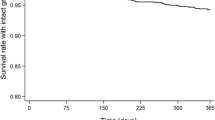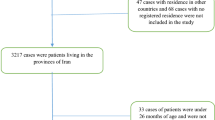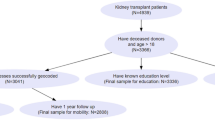Abstract
Background
Evidence of geographical differences in liver transplantation (LT) outcomes has been proposed as a reason to include community characteristics in risk adjustment of transplant quality metrics. However, consistency and utility of rankings in LT outcomes for counties have not been demonstrated.
Aims
We sought to evaluate the utility of county rankings (county socioeconomic status (SES) or county health scores (CHS)) on outcomes after LT.
Methods
Using the United Network for Organ Sharing Registry, adults ≥ 18 years of age undergoing LT between 2002 and 2014 were identified. County-specific 1-year survival was calculated using the Kaplan–Meier method for counties with ≥ 5 LT performed during this period. Agreement between high-risk designation by 1-year mortality rate and county ranking was calculated using the Spearman correlation coefficient.
Results
The analysis included 47,769 LT recipients in 1092 counties. County 1-year mortality rates were not correlated with county CHS (Spearman ρ = 0.01, p = 0.694) or county SES (Spearman ρ = − 0.01, p = 0.734). After controlling for individual-level covariates, a statistically significant variability in mortality hazards across counties (p < 0.001) persisted. Although both CHS and SES measures improved the model fit (p = 0.004 and p = 0.048, respectively), an unexplained residual variation in mortality hazard across counties continued.
Conclusions
There is poor agreement between county rankings on various socioeconomic indicators and LT outcomes. Although there is variability in outcomes across counties, this appears not to be due to county-level socioeconomic indices.


Similar content being viewed by others
Abbreviations
- LT:
-
Liver transplantation
- SES:
-
Socioeconomic status
- CHS:
-
County health scores
- NQF:
-
National Quality Forum
- DHHS:
-
Department of Health and Human Services
- ACS:
-
American Community Survey
- ESLD:
-
End-stage liver disease
- MELD:
-
Model for end-stage liver disease
- US:
-
United States
- UNOS:
-
United Network for Organ Sharing
- DRI:
-
Donor risk index
- LOS:
-
Length of stay
- HR:
-
Hazard ratios
- CI:
-
Confidence interval
References
Bennett KM, Scarborough JE, Pappas TN, Kepler TB. Patient socioeconomic status is an independent predictor of operative mortality. Ann Surg. 2010;252:552–558.
Haider AH, Scott VK, Rehman KA, et al. Racial disparities in surgical care and outcomes in the United States: a comprehensive review of patient, provider, and systemic factors. J Am Coll Surg. 2013;216:482–492.e412.
National Quality Forum. Risk Adjustment for Socioeconomic Status or Other Sociodemographic Factors. Risk Adjustment and SES. 2014.
Duda L. National Organ Allocation Policy: The final rule. Virtual Mentor 2005;7:604–607.
Ellison MD, Edwards LB, Edwards EB, Barker CF. Geographic differences in access to transplantation in the United States. Transplantation. 2003;76:1389–1394.
Adler JT, Yeh H. Social determinants in liver transplantation. Clin Liver Dis. 2016;7:15–17.
Adler JT, Bababekov YJ, Markmann JF, Chang DC, Yeh H. Distance is associated with mortality on the waitlist in pediatric liver transplantation. Pediatr Transplant. 2017;21:e12842.
Yeh H, Smoot E, Schoenfeld DA, Markmann JF. Geographic inequity in access to livers for transplantation. Transplantation. 2011;91:479–486.
Yoo HY, Thuluvath PJ. Outcome of liver transplantation in adult recipients: influence of neighborhood income, education, and insurance. Liver Transplant. 2004;10:235–243.
Quillin RC III, Wilson GC, Wima K, et al. Neighborhood level effects of socioeconomic status on liver transplant selection and recipient survival. Clin Gastroenterol Hepatol. 2014;12:1934–1941.
Schold JD, Phelan MP, Buccini LD. Utility of ecological risk factors for evaluation of transplant center performance. Am J Transplant. 2017;17:617–621.
Miller R, Akateh C, Thompson N, et al. County socioeconomic characteristics and pediatric renal transplantation outcomes. Pediatr Nephrol. 2018;33:1227–1234.
Ross K, Patzer RE, Goldberg DS, Lynch RJ. Sociodemographic determinants of waitlist and posttransplant survival among end-stage liver disease patients. Am J Transplant. 2017;17:2879–2889.
County Health Rankings and Roadmaps. http://www.countyhealthrankings.org/rankings/data. Published 2017.
Roux AVD, Merkin SS, Arnett D, et al. Neighborhood of residence and incidence of coronary heart disease. N Engl J Med. 2001;345:99–106.
Bureau UC. American Community Survey Data Releases. 2017.
Feng S, Goodrich NP, Bragg-Gresham JL, et al. Characteristics associated with liver graft failure: the concept of a donor risk index. Am J Transplant. 2006;6:783–790.
Beal EW, Black SM, Mumtaz K, et al. High center volume does not mitigate risk associated with using high donor risk organs in liver transplantation. Dig Dis Sci. 2017;62:2578–2585. https://doi.org/10.1007/s10620-017-4639-2.
Tumin D, Horan J, Shrider EA, et al. County socioeconomic characteristics and heart transplant outcomes in the United States. Am Heart J. 2017;190:104–112.
Singh TP, Gauvreau K. Center effect on post-transplant survival among currently active United States pediatric heart transplant centers. Am J Transplant. 2018;18:2914–2923.
DuBay DA, MacLennan PA, Reed RD, et al. Insurance type and solid organ transplantation outcomes: a historical perspective on how medicaid expansion might impact transplantation outcomes. J Am Coll Surg. 2016;223:611–620.e614.
Johnson AM, Johnson A, Hines RB, Bayakly R. The effects of residential segregation and neighborhood characteristics on surgery and survival in patients with early-stage non-small cell lung cancer. Cancer Epidemiol Biomark Prev. 2016;25:750.
Dwyer-Lindgren L, Bertozzi-Villa A, Stubbs RW, et al. Us county-level trends in mortality rates for major causes of death, 1980–2014. JAMA. 2016;316:2385–2401.
Dwyer-Lindgren L, Bertozzi-Villa A, Stubbs R, et al. Inequalities in life expectancy among US Counties, 1980 to 2014 temporal trends and key drivers. JAMA Intern Med. 2017;177:1003–1011.
Foraker RE, Rose KM, Kucharska-Newton AM, Ni H, Suchindran CM, Whitsel EA. Variation in rates of fatal coronary heart disease by neighborhood socioeconomic status: the atherosclerosis risk in communities surveillance (1992–2002). Ann Epidemiol. 2011;21:580–588.
Schold JD, Heaphy ELG, Buccini LD, et al. Prominent impact of community risk factors on kidney transplant candidate processes and outcomes. Am J Transplant. 2013;13:2374–2383.
Akateh C, Tumin D, Beal EW, et al. Change in health insurance coverage after liver transplantation can be associated with worse outcomes. Dig Dis Sci. 2018;63:1463–1472. https://doi.org/10.1007/s10620-018-5031-6.
Beal EW, Tumin D, Mumtaz K, et al. Factors contributing to employment patterns after liver transplantation. Clin Transplant. 2017;31:e12967.
Kemmer N, Zacharias V, Kaiser TE, Neff GW. Access to liver transplantation in the MELD era: role of ethnicity and insurance. Dig Dis Sci. 2008;54:1794. https://doi.org/10.1007/s10620-008-0567-5.
Barshes NR, Becker NS, Washburn WK, Halff GA, Aloia TA, Goss JA. Geographic disparities in deceased donor liver transplantation within a single UNOS region. Liver Transplant. 2007;13:747–751.
Goldberg DS, French B, Forde KA, et al. Association of distance from a transplant center with access to waitlist placement, receipt of liver transplantation, and survival among us veterans. JAMA. 2014;311:1234–1243.
Funding
This research was supported by the NIH T32AI 106704-05 training Grant.
Author information
Authors and Affiliations
Corresponding author
Ethics declarations
Conflict of interest
The authors have no conflicts of interest to disclose.
Additional information
Publisher's Note
Springer Nature remains neutral with regard to jurisdictional claims in published maps and institutional affiliations.
Disclaimer
The data reported in this manuscript were supplied by the United Network for Organ Sharing as the contractor for the Organ Procurement and Transplantation Network. The interpretation and reporting of these data are the responsibility of the authors and in no way should be seen as an official policy of or interpretation by the OPTN or the US Government.
Rights and permissions
About this article
Cite this article
Akateh, C., Miller, R., Beal, E.W. et al. County Rankings Have Limited Utility When Predicting Liver Transplant Outcomes. Dig Dis Sci 65, 104–110 (2020). https://doi.org/10.1007/s10620-019-05734-z
Received:
Accepted:
Published:
Issue Date:
DOI: https://doi.org/10.1007/s10620-019-05734-z




